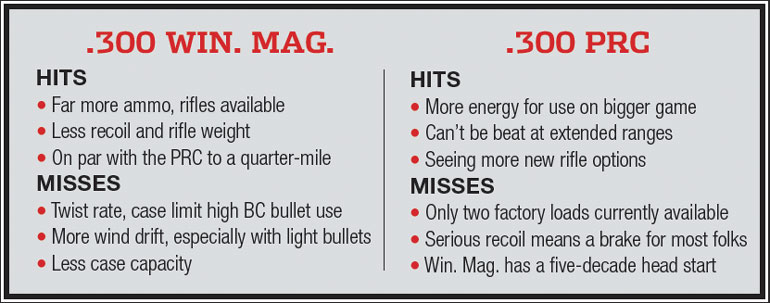
The .300 Win. Mag. debuted way back in 1963 and was an immediate success. Based on a shortened .300 H&H Mag. case, the .300 Win. Mag. offered better ballistics than the H&H from lighter, standard-length actions. To improve performance from the Win. Mag.’s shorter 2.62-inch belted case, engineers removed most of the parent cartridge’s body taper and increased case capacity.
The .300 Win. Mag.’s popularity continued to grow. By the 1990s it surpassed the .30-06 as the cartridge that had collected the most Boone & Crockett record-book animals.
Over the decades other hot .30s have challenged the .300 Win. Mag. for its crown, but none has done serious damage to its appeal. But in 2018 Hornady came out with a totally different fast .30. Known as the .300 PRC (Precision Rifle Cartridge), this new beltless offering is based on the .375 Ruger, a beltless magnum that outperforms the .375 H&H in a standard-length action.
Both the .300 Win. Mag. and the .300 PRC feature a rim diameter of .532 inch, so both require a magnum bolt face. The .300 PRC’s case is the same diameter as the .300 Win. Mag.’s belt, and the .300 PRC has less taper and a 30-degree shoulder as opposed to the .300 Win. Mag.’s 25-degree shoulder. So even though the .300 PRC case is slightly shorter at 2.58 inches than the Win. Mag., it offers about five percent more capacity.
The .300 PRC has a long neck and added head height, which allow it to be loaded with high ballistic-coefficient bullets. The .300 PRC was designed as the ultimate precision long-range, medium-bore rifle cartridge, and even though it’s only a couple years old, the PRC is already a standout in the world of precision shooting.

The .300 PRC has some serious street cred, but it doesn’t beat the Win. Mag. on all fronts. For starters, the Winchester will fit in a standard-length action without modification. The .300 PRC will fit in most long actions, but the cartridge’s greater overall length—3.34 inches for the Win. Mag. versus 3.70 for the PRC—will likely require a longer magazine.
The .300 Win. Mag. isn’t that far behind .300 PRC ballistically. Hornady’s .300 PRC Precision Hunter load pushes a 212-grain ELD-X bullet from the muzzle at 2,860 fps while the company’s .300 Win. Mag. Precision Hunter load fires a 200-grain ELD-X bullet at 2,850 fps. With a 100-yard zero the .300 Win. Mag. drops 12 inches at 300 yards while the .300 PRC drops 11.6 inches.
The Winchester does all this with less recoil. What’s more, most .300 Win. Mag. barrels have 1:10 twists and will effectively shoot bullets ranging from 150 grains up to 200. The .300 PRC features a 1:8 twist, ideal for bullets from 200 grains and heavier.
But if you look more deeply at the ballistics, you’ll notice a gap. The .300 PRC consistently carries 250 to 300 additional foot-pounds of energy over the Winchester at practical hunting ranges. At 1,000 yards the .300 Win. Mag. load drops about 20 inches more than the .300 PRC, but the most dramatic difference is in handling wind.
At 1,000 yards the 212-grain .300 PRC drifts 10 inches less in a 10-mph crosswind than the .300 Win. Mag. Now that Hornady is offering its 250-grain .308 A-Tip bullets with a G1 BC of .878, handloaders can really improve ultra-long-range performance. And because the .300 PRC has less free-bore and headspaces off the shoulder rather than the belt, accuracy potential is excellent.
In practical terms, both will serve hunters and shooters well. Hunters will appreciate the .300 Win. Mag.’s wide selection of rifles and ammunition, while target shooters will like the .300 PRC’s accuracy and ballistics. Ultimately, it depends on whether you want the .300 Win. Mag.’s versatility or the .300 PRC’s long-range potential.











































